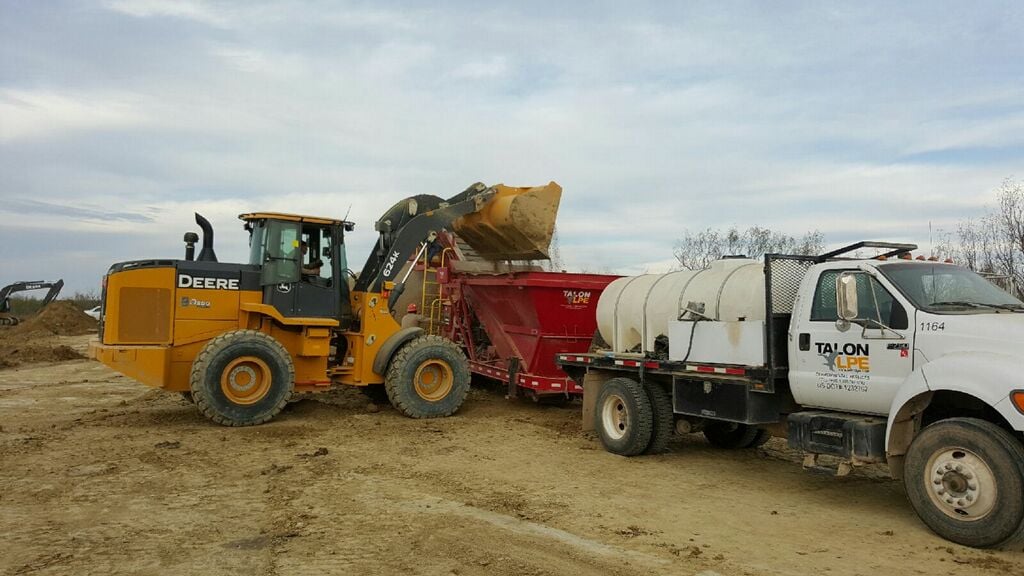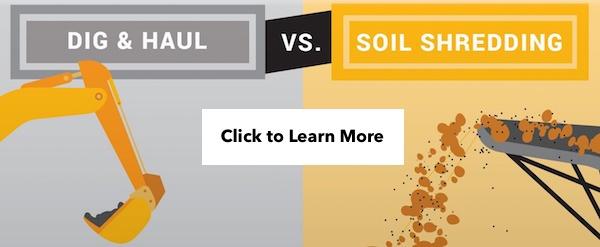There are two generally accepted methods of ex-situ soil remediation, “dig and haul” and landfarming. Dig and haul can be quick, but can also be expensive when you account for additional costs such as purchasing backfill material. Don’t forget about the long-term risks associated with your contaminated soils sitting in a landfill for the next 30 years. Landfarming may be more or less expensive depending on contaminant levels and volume but generally takes weeks to months to complete and requires an accessible area to operate the “farm.” Depending on location, it may also require a special permit.
 Talon/LPE has been utilizing soil shredding technology to remediate contaminated soils as a new solution to an old problem. Soil shredding can often be cheaper, faster, and better than the standard methods.
Talon/LPE has been utilizing soil shredding technology to remediate contaminated soils as a new solution to an old problem. Soil shredding can often be cheaper, faster, and better than the standard methods.
What Is Soil Shredding?
Soil shredding is the process of mechanically breaking down the contaminated soils to a much smaller particle size. The mechanical aeration allows for better volatilization by reducing the particle size and thus exposing more surface area to the atmosphere. This provides an immediate reduction in many contaminant levels.
We can enhance simple soil shredding by applying a biological or chemical liquid to the reduced soil particles as they are exiting the soil shredding machine. This approach provides an even distribution of the liquid to the soils. This additional step is optional and the need for liquid amendments depends on site-specific conditions and goals.
The now treated soil is stockpiled as it leaves the shredding machine. The stockpile has a much smaller footprint compared to landfarming. Depending on site specific conditions and added soil amendments, we may turn the stockpiled soil or leave as is.
One of our team members regularly monitors the stockpiled soil with a field screening tool (PID or FID). We also collect confirmation soil samples for submittal to a laboratory for analysis. We use this data to determine when the soil has met remediation goals. If necessary, the stockpiled soil may be processed a second time through the soil shredding machine.
If the laboratory analytical testing shows contamination levels below regulatory limits, the newly cleaned soil may be returned to the excavation or transported to another location. Typically, the goal is to return the soil to the same excavation. Moving the treated soil to an off-site location may require a permit. Talon/LPE can acquire any permits, if necessary.
What Are The Benefits Of Soil Shredding?
Soil shredding has certain benefits that make it attractive for our clients:
Soil shredding is a cost-effective option for removing certain kinds of contaminants from the soil. It works especially with volatile contaminants like hydrocarbons.
This ex-situ remediation method is mobile and may be utilized on-site or at an approved off-site location. To keep costs low, the soil shredding typically occurs at the same location as the excavation location.
Soil shredding eliminates costs associated with loading the trucks, truck transportation, and landfill fees.
Soil shredding removes the risks and liability associated with transportation of contaminated soil on public roadways to reach its final destination, a landfill, where it will remain indefinitely.
This process removes the need for bringing in backfill to return the excavation to its prior state. When contaminated soils are transported off-site, the excavated space must be backfilled with soil brought in from another location. This translates into a higher cost for the client.
If groundwater is also determined to be impacted, Talon/LPE has the experience to assess and remediate groundwater. There is no need to call in another environmental consultant.
Contact Talon/LPE to discuss how soil shredding can save money on your next soil remediation project. We are an environmental consulting, engineering, drilling, and construction firm, providing services in Texas, Oklahoma, and New Mexico.
 Talon/LPE has been utilizing soil shredding technology to remediate contaminated soils as a new solution to an old problem. Soil shredding can often be cheaper, faster, and better than the standard methods.
Talon/LPE has been utilizing soil shredding technology to remediate contaminated soils as a new solution to an old problem. Soil shredding can often be cheaper, faster, and better than the standard methods.What Is Soil Shredding?
Soil shredding is the process of mechanically breaking down the contaminated soils to a much smaller particle size. The mechanical aeration allows for better volatilization by reducing the particle size and thus exposing more surface area to the atmosphere. This provides an immediate reduction in many contaminant levels.
We can enhance simple soil shredding by applying a biological or chemical liquid to the reduced soil particles as they are exiting the soil shredding machine. This approach provides an even distribution of the liquid to the soils. This additional step is optional and the need for liquid amendments depends on site-specific conditions and goals.
The now treated soil is stockpiled as it leaves the shredding machine. The stockpile has a much smaller footprint compared to landfarming. Depending on site specific conditions and added soil amendments, we may turn the stockpiled soil or leave as is.
One of our team members regularly monitors the stockpiled soil with a field screening tool (PID or FID). We also collect confirmation soil samples for submittal to a laboratory for analysis. We use this data to determine when the soil has met remediation goals. If necessary, the stockpiled soil may be processed a second time through the soil shredding machine.
If the laboratory analytical testing shows contamination levels below regulatory limits, the newly cleaned soil may be returned to the excavation or transported to another location. Typically, the goal is to return the soil to the same excavation. Moving the treated soil to an off-site location may require a permit. Talon/LPE can acquire any permits, if necessary.
What Are The Benefits Of Soil Shredding?
Soil shredding has certain benefits that make it attractive for our clients:
Soil shredding is a cost-effective option for removing certain kinds of contaminants from the soil. It works especially with volatile contaminants like hydrocarbons.
This ex-situ remediation method is mobile and may be utilized on-site or at an approved off-site location. To keep costs low, the soil shredding typically occurs at the same location as the excavation location.
Soil shredding eliminates costs associated with loading the trucks, truck transportation, and landfill fees.
Soil shredding removes the risks and liability associated with transportation of contaminated soil on public roadways to reach its final destination, a landfill, where it will remain indefinitely.
This process removes the need for bringing in backfill to return the excavation to its prior state. When contaminated soils are transported off-site, the excavated space must be backfilled with soil brought in from another location. This translates into a higher cost for the client.
If groundwater is also determined to be impacted, Talon/LPE has the experience to assess and remediate groundwater. There is no need to call in another environmental consultant.
Contact Talon/LPE to discuss how soil shredding can save money on your next soil remediation project. We are an environmental consulting, engineering, drilling, and construction firm, providing services in Texas, Oklahoma, and New Mexico.


